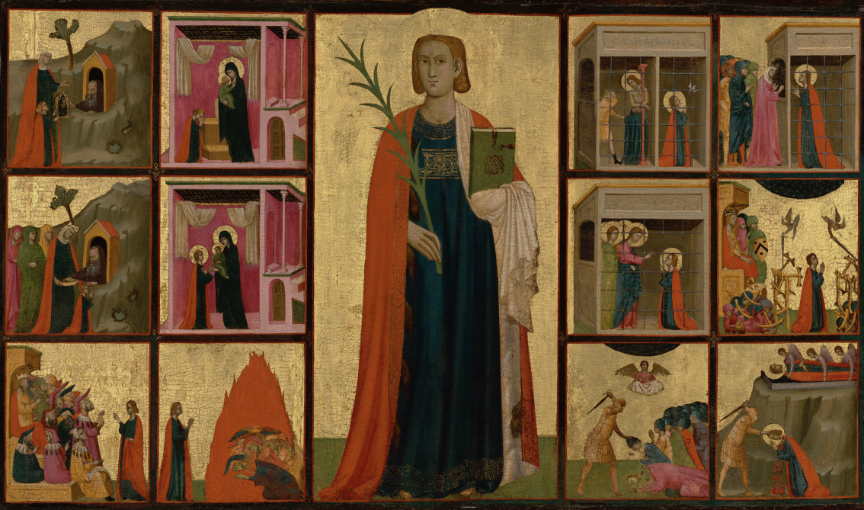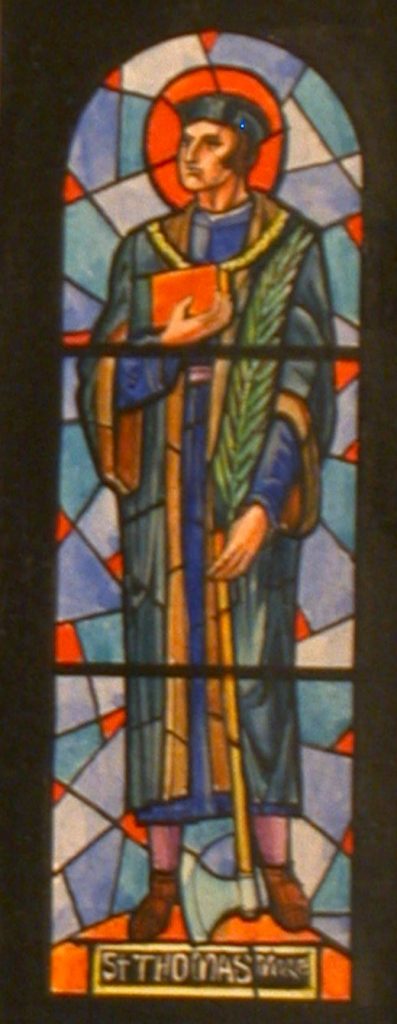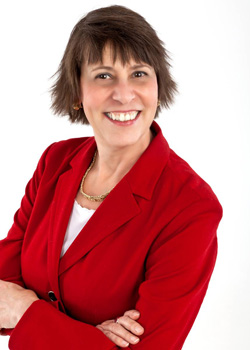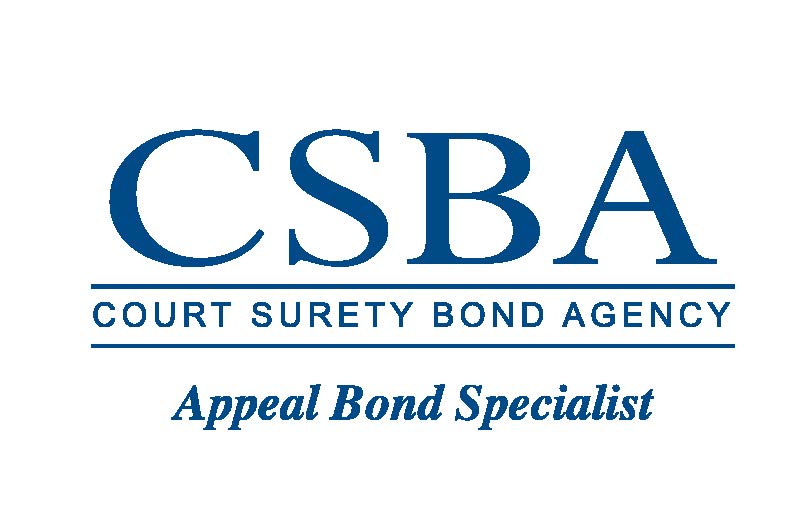By Wendy S. Loquasto, Fox & Loquasto, LLC

On May 19, 1935, four centuries after Thomas More was beheaded for refusing to take the oath acknowledging King Henry VIII as the head of the Church of England and renouncing obedience to the pope, he was canonized as a martyr. Today the former lord chancellor is a patron saint of lawyers, politicians, and statesmen.
Professor Brendan Brown of Catholic University’s School of Law wrote a wonderful article about the life and times of St. Thomas More, which was published in Fordham Law Review in 1935.[1] University of Virginia Law Professor Garrard Glenn’s address to the Saint Thomas More Society of America in Washington, D.C., on May 16, 1940, concerning More’s impact on the law was also published in Fordham Law Review.[2]This article draws heavily from those sources, both of which I recommend for further reading.
Thomas More was born in 1478.[3] He began his classical education studies at Oxford when he was 14 years old. In 1494, he started his legal studies at London’s New Inn and two years later he entered Lincoln’s Inn of Court, becoming an outer barrister, bencher, and reader at Furnival’s Inn.[4]
Thomas More had a lucrative and distinguished practice. He participated as counsel in all the important lawsuits of the day and there are estimates of significant income.[5] Yet he also gave his legal services gratuitously to widows, orphans, and paupers.[6] His practice included maritime and international law. His successful defense of the papal right to a ship that King Henry VIII contended should be forfeited to the Crown attracted Henry’s attention and led to More becoming a member of the royal court.[7] He was knighted in 1521.[8]
Like many of today’s lawyers, Thomas More was drawn to public service and politics. His political rise from member of parliament to lord chancellor has been described as follows:

Pre-eminent distinction awaited St. Thomas in the broader field of public law and politics. Thus he was elected a member of Parliament, in 1504, when he was but twenty-six years of age, fighting for the rights of the common people against the unreasonable requests for money which Henry VII was then making. Eventually, he became speaker of the House of Commons, namely, in 1523, and he again used all his resources to resist autocratic assumption of unconstitutional powers by unscrupulous ministers of State. In 1510, he filled the position of under-sheriff of the City of London, a very important post at that time, and continued there until 1519, when he was called to the Royal Court. He was made a member of the Privy Council, which was both a deliberative and judicial body. He became under-treasurer of the Exchequer, in 1521, and later Chancellor of the Duchy of Lancaster. At the age of fifty-one, he was appointed Lord High Chancellor, upon the recommendation of his immediate predecessor, Cardinal Wolsey, serving in that capacity from October, 1529, to May, 1532.[[9]]
Sir Thomas More was the first lawyer to become Lord High Chancellor, the office having been previously held by members of the clergy.[10] His duties included being a cabinet minister and keeper of the Great Seal of the Realm, as well as keeper of the king’s conscience; presiding as Speaker of the House of Lords; and being head of the judiciary, including the Courts of Chancery (equity).[11]
Although Sir Thomas More was lord chancellor for less than three years, he left a huge legacy through substantive and procedural reforms.[12] He strove to remedy defects in the English penal system, was responsible for the passage of statutes that did away with extortion in the probate of wills, and advocated changes in the law against the forfeiture of land upon default.[13] He established better relations between the common law and equity courts and cleared the equity court calendar of unheard cases, some of which had been pending for 20 years.[14] He created a rule that no subpoena would issue until he himself reviewed the case, which eliminated the graft of minor officials who demanded a subsidy before process could be issued. In this one rule, More converted the chancery into a court of justice, an impersonal tribunal open to all.[15]
It has been said that Thomas More discharged his judicial duties speedily and conscientiously and avoided all appearance of favoritism and nepotism.[16] There are many legends of his judicial wisdom, including one pertaining to the ownership of a dog, lost by a poor woman, that had come into the possession of More’s wife. More had each woman stand at opposite ends of the hall and call the dog. The animal went to the poor woman, and she was declared the dog’s rightful owner. He then purchased the dog and gave it to his wife, which delighted all the parties.[17]
What caused this highly respected, top-ranking official to fall from grace and meet his end by execution? The answer lies with the English Protestant Reformation and St. Thomas More’s firm belief that papal supremacy in spiritual affairs was divinely ordained.[18]
You may recall from your history lessons that King Henry VIII married six times in the hope of obtaining a male heir. It was the dissolution of his first marriage to Catherine of Aragon so he could marry Anne Boleyn that sparked England’s Reformation. Although much could be said on this topic, for this article, I will simply say that Thomas More was a devout Catholic opposed to annulment, but he was initially able to take the position of noninterference in Henry’s martial affairs, asserting he was neither theologian nor canonical lawyer.[19] Cardinal Wolsey, who was then lord chancellor, bore the blame for failing to secure the pope’s agreement to the annulment, resulting in his removal from office. It was then, in 1529, that More became lord chancellor. Although he endeavored to maintain his policy of noninterference, he ultimately realized he would be required to perform acts that interfered with his integrity, and he resigned the chancellorship in May 1532.[20]
In 1533, Henry VIII obtained a divorce from Catherine and married Anne Boleyn. Sir Thomas More declined to attend her coronation, and instead wrote a letter of congratulations, but his absence offended the monarchs.[21] In 1534, Parliament passed a law that made Henry’s children by Anne Boleyn the lawful successors to the throne. More was summoned to take an oath, unconstitutionally broader than mere royal succession, that required acknowledging Henry as the head of the Church of England and renouncing “all obedience to the Bishop of Rome as having no more power than any other Bishop.”[22] Because More believed papal supremacy was divinely ordained, he declined to take the oath.
In November 1534, Thomas More was charged with treason for not taking the oath required by the Act of Supremacy and he was imprisoned.[23] Unsuccessful efforts were made to persuade More to take the oath and to obtain evidence against him.[24] Obvious perjury was used against him at a trial. In the end, he was convicted by a court that included Anne Boylen’s relatives and sentenced to death.[25]
Thomas More died on July 6, 1535, buoyed up by faith in his own reason and conscience. He was willing to die in defense of a jurisdictional tenet, namely, the incapacity of any person to deprive the papacy of its right to exercise supreme authority in matters of faith and morals.[26] He declared from the scaffold that he died “the king’s good servant, but God’s first.”[27]
St. Thomas More was beatified as a martyr, along with St. John Fisher, Bishop of Rochester, and 52 other English martyrs on December 29, 1886.[28] He was canonized with St. John Fisher on May 19, 1935, by Pope Pius XI, with full ceremony in St. Peter’s Basilica.[29] The homily at the papal mass for More’s canonization stated:
A strong and courageous spirit . . . when he saw that the doctrines of the Church were gravely endangered, he knew how to despise resolutely the flattery of human respect, how to resist, in accordance with his duty, the supreme head of the State when there was question of things commanded by God and the Church, and how to renounce with dignity the high office with which he was invested. It was for these motives that he too was imprisoned, nor could the tears of his wife and children make him swerve from the path of truth and virtue.
In that terrible hour of trial he raised his eyes to heaven, and proved himself a bright example of Christian fortitude.[[30]]
Today, nearly 500 years after his death, St. Thomas More remains a figure of great inspiration to lawyers and politicians. In seeking his guidance, this prayer is appropriate:
I pray, for the glory of God and in the pursuit of His justice, that I, with You, St. Thomas More, may be trustworthy with confidences, keen in study, accurate in analysis, correct in conclusion, able in argument, loyal to clients, honest with all, courteous to adversaries, ever attentive to conscience[[31]]
[1]. Brendan F. Brown, St. Thomas More, Lawyer, 4 Fordham L. Rev. 375 (1935), available at https://ir.lawnet.fordham.edu/cgi/viewcontent.cgi?article=1064&context=flr.
[2]. Garrard Glenn, St. Thomas More as Judge & Lawyer, 10 Fordham L. Rev. 187 (1941), available at https://ir.lawnet.fordham.edu/cgi/viewcontent.cgi?article=1232&context=flr.
[3]. St. Thomas More, Catholic Online (A Project of Your Catholic Voice Foundation), https://www.catholic.org/saints/saint.php?saint_id=324 (last visited Mar. 10, 2021).
[4]. Brendan F. Brown, St. Thomas More, Lawyer, 4 Fordham L. Rev. 378-79 (1935).
Inns of Court and their associated Inns of Chancery emerged toward the end of the 13th or beginning of the 14th century. In 1292, King Edward I took the King’s Courts out of the hands of the clergy and placed them under the control of judges, and as a direct result professionally trained lawyers began to emerge. Aspiring lawyers went to London to listen and learn from established practitioners. The Inns of Chancery were essentially preparatory schools for the Inns of Court. The Inns were large houses used as hostels for students or apprentices. Records show that London Inn, which still exists today as the oldest continuous Inn, dates back to before 1422, and its Inns of Chancery were Furnival’s Inn and Thavie’s Inn. See The History of the Inn, The Honourable Society of Lincoln’s Inn, https://www.lincolnsinn.org.uk/about-us/the-history-of-the-inn/ (last visited Mar. 10, 2021).
[5]. Brendan F. Brown, St. Thomas More, Lawyer, 4 Fordham L. Rev. at 379 & n.22.
[6]. Id. at 383.
[7]. Id. at 380.
[8]. Id. at 377 n.11; see also Biography of Sir Thomas More, The Thomas More Loyola Law School American Inn of Court, American Inns of Court, https://inns.innsofcourt.org/for-members/inns/the-thomas-more-loyola-law-school-american-inn-of-court/biography-of-sir-thomas-more/ (last visited Mar. 10, 2021).
[9]. Brendan F. Brown, St. Thomas More, Lawyer, 4 Fordham L. Rev. at 380.
[10]. Garrard Glenn, St. Thomas More as Judge & Lawyer, 10 Fordham L. Rev. at 190.
[11]. Lord Chancellor, Parliament of the United Kingdom, https://www.parliament.uk/about/living-heritage/evolutionofparliament/parliamentwork/offices-and-ceremonies/overview/lord-chancellor1/ (last visited Mar. 10, 2021).
[12]. Brendan F. Brown, St. Thomas More, Lawyer, 4 Fordham L. Rev. at 381-82.
[13]. Id. at 382; Garrard Glenn, St. Thomas More as Judge & Lawyer, 10 Fordham L. Rev. at 190-93.
[14]. Brendan F. Brown, St. Thomas More, Lawyer, 4 Fordham L. Rev. at 382.
[15]. Id. at 382; Garrard Glenn, St. Thomas More as Judge & Lawyer, 10 Fordham L. Rev. at 191.
[16]. Brendan F. Brown, St. Thomas More, Lawyer, 4 Fordham L. Rev. at 382.
[17]. Id. at 383.
[18]. Id. at 387.
[19]. Id. at 385.
[20]. Id. at 384.
[21]. St. Thomas More, Catholic Online (A Project of Your Catholic Voice Foundation), https://www.catholic.org/saints/saint.php?saint_id=324 (last visited Mar. 10, 2021).
[22]. Brendan F. Brown, St. Thomas More, Lawyer, 4 Fordham L. Rev. at 385-86.
[23]. Id. at 386.
[24]. Id. at 387.
[25]. Id. at 387-88; St. Thomas More, Catholic Online (A Project of Your Catholic Voice Foundation), https://www.catholic.org/saints/saint.php?saint_id=324 (last visited Mar. 10, 2021).
[26]. Brendan F. Brown, St. Thomas More, Lawyer, 4 Fordham L. Rev. at 388-89.
[27]. Id. at 390.
[28]. Biography of Sir Thomas More, The Thomas More Loyola Law School American Inn of Court, American Inns of Court, https://inns.innsofcourt.org/for-members/inns/the-thomas-more-loyola-law-school-american-inn-of-court/biography-of-sir-thomas-more/ (last visited Mar. 10, 2021). St. John Fisher also refused to take the oath. St. John Fisher, Catholic Online (A Project of Your Catholic Voice Foundation), https://www.catholic.org/saints/saint.php?saint_id=688 (last visited Mar. 10, 2021).
[29]. Brendan F. Brown, St. Thomas More, Lawyer, 4 Fordham L. Rev. at 375-76 & nn. 1 & 4.
[30]. Homily at the Canonization of St. Thomas More: By Pope Pius XI, The Remnant Newspaper (A National Catholic Newspaper Established 1967), https://www.remnantnewspaper.com/web/index.php/articles/item/3302-homily-at-the-canonization-of-st-thomas-more-by-pope-pius-xi (posted July 24, 2017).
[31]. A Lawyer’s Prayer to St. Thomas More, Center for Thomas More Studies, https://www.thomasmoresociety.org/about/sir-thomas-more/#:~:text=I%20pray%2C%20for%20the%20glory,adversaries%2C%20ever%20attentive%20to%20conscience (last visited Nov. 14, 2020).
I pray, for the glory of God and in the pursuit of His justice, that I, with You, St. Thomas More, may be trustworthy with confidences, keen in study, accurate in analysis, correct in conclusion, able in argument, loyal to clients, honest with all, courteous to adversaries, ever attentive to conscience[ ]

Wendy Loquasto is the manager of Fox & Loquasto, LLC. She has been board-certified in Appellate Practice since 2008, is a past chair of the Appellate Court Rules Committee (2014-2015), and has served two terms on the Appellate Practice Section’s Executive Council (2004-2011 & 2014-2017). She has a general practice that includes workers’ compensation, civil, and criminal appeals, as well as writs and trial support. She is the former president of Tallahassee Women Lawyers (1996-1997) and the Florida Association of Women Lawyers (2006-2007), as well as Legal Services of North Florida, Inc. (2009-2011).


